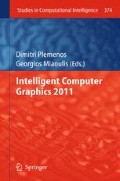Abstract
Basic ideas and requirements can be outlined by a design through ambiguous terms in order to define a desirable scene. Declarative modeling approach receives a rudimentary description and produces a set of scenes that are close to designer view. The reverse declarative modeling paradigm supports the designer to distinguish a set of scenes, accommodate further the pre-selected scenes to his needs, and produces a new enriched declarative description which initiates a new forward declarative design cycle for new promising scenes. The aim of the present work is to enhance the communication between the designer and machine, in such a way to increase the designer understanding and perception, by structuring a description in textual mode, reflecting all necessary semantic and geometric information, whenever the designer alters the pre-selected scenes.
Access this chapter
Tax calculation will be finalised at checkout
Purchases are for personal use only
Preview
Unable to display preview. Download preview PDF.
References
Plemenos, D.: A contribution to study and development of scene modeling, generation and display techniques – the MultiFormes project, Professorial dissertation, Nantes, France (November 1991)
Plemenos, D.: Declarative modeling by hierarchical decomposition. In: The Actual State of the MultiFormes project, International Conference Graphic. Con. 1995, St. Petersburg, Russia (July 1995)
Golfinopoulos, V., Bardis, G., Makris, D., Miaoulis, G., Plemenos, D.: Multiple scene understanding for declarative scene modeling. In: 3IA 2007 International Conference on Computer Graphics and Artificial Intelligence, Athens, Greece, pp. 39–49 (2007); ISBN 0-7695-3015-X
Russell, S., Norving, P.: Artificial Intelligence: A modern approach. Prentice Hall, New Jersey (2003)
Miaoulis, G.: Contribution à l’étude des Systèmes d’Information Multimédia et Intelligent dédiés à la Conception Déclarative Assistée par l’Ordinateur Le projet MultiCAD, Ph.D. Thesis, University of Limoges, France (2002)
Plemenos, D., Tamine, K.: Increasing the efficiency of declarative modeling. Constraint evaluation for the hierarchical decomposition approach. In: International Conference WSCG 1997, Plzen, Czech Republic (1997)
Makris, D.: Aesthetic–Aided Intelligent 3D Scene Synthesis. In: Miaoulis, G., Plemenos, D. (eds.) Intelligent Scene Modelling Information Systems. SCI, vol. 181. Springer, Heidelberg (2009) ISBN 978-3-540-92901-7
Ravani, I., Makris, D., Miaoulis, G., Constantinides, P., Petridis, A., Plemenos, D.: Implementation of architecture-oriented knowledge framework in MultiCAD declarative scene modeling system. In: 1st Balcan Conference in Informatics, Greece (2003)
Dragonas, J.: Modélisation déclarative collaborative. Systèmes collaboratifs pour la modélisation déclarative en synthèse d’image, Ph.D. Thesis, University of Limoges, France (June 2006)
Bardis, G.: Intelligent Personalization in a Scene Modeling Environment. In: Miaoulis, G., Plemenos, D. (eds.) Intelligent Scene Modelling Information Systems. SCI, vol. 181. Springer, Heidelberg (2009) ISBN 978-3-540-92901-7
Ravani, I., Makris, D., Miaoulis, G., Plemenos, D.: Concept-Based declarative description subsystem for CADD. In: 3IA 2004 International Conference, Limoges, France (2004)
Miaoulis, G., Plemenos, D., Skourlas, C.: MultiCAD Database: Toward a unified data and knowledge representation for database scene modeling. In: 3IA 2000 International Conference, Limoges, France (2000)
Golfinopoulos, V.: Understanding Scenes. In: Miaoulis, G., Plemenos, D. (eds.) Understanding Scenes. SCI, vol. 181. Springer, Heidelberg (2009); ISBN 978-3-540-92901-7
Sagerer, G., Niewmann, H.: Semantic networks for understanding scenes. Plenum Press, N. York (1997)
Reiter, E., Dale, R.: Building Natural Language Generation Systems. Cambridge University Press, Cambridge (2000)
Mellish, C., Evans, R.: Implementation architectures for natural language generation. Natural Language Engineering 10(3/4), 261–282 (2004)
Lu, W., Ng, H.T., Lee, W.S.: Natural language generation with tree conditional random fields. In: Conference on Empirical Methods in Natural Language Processing, pp. 400–409 (2009)
Garoufi, K., Koller, A.: Automated planning for situated language generation. In: 48th Annual Meeting of the Association for Computational Linguistics, Uppsala, Sweden, pp. 1573–1582 (2010)
Paris, C., Coloineau, N., Lampert, A., Vander Linden, K.: Discourse planning for information composition and delivery: a reusable platform. Natural Language Engineering 16(1), 61–98 (2009)
Mellish, C., Scott, D., Cahill, L., Paiva, D., Evans, R., Reape, M.: A reference architecture for natural language generation systems. Natural Language Engineering 12(1), 1–34 (2006)
O’Donnell, M., Mellish, C., Oberlander, J., Knott, A.: ILEX: an architecture for a dynamic hypertext generation system. Natural Language Engineering 7(13), 225–250 (2001)
Kosseim, L., Lapalme, G.: Choosing rhetorical structures to plan instructional texts. Computational Intelligence 16(3), 408–445 (2000)
Davey, A.: Discourse Production: A Computer Model of Some Aspects of a Speaker. Edinburgh University Press, Edinburgh (1979)
Goldberg, E., Driedger, N., Kittredge, R.: Using natural-language processing to produce weather forecasts. IEEE Expert 9(2), 45–53 (1994)
Lavoie, B., Rambow, O., Reiter, E.: A fast and portable realizer for text generation. In: Proceedings of the Fifth Conference on Applied Natural Language Processing, pp. 265–268 (1997)
Paris, C., Colineau, N., Lu, S., Vander Linden, K.: Automatically Generating Effective Online Help. International Journal on E-Learning 4(1), 83–103 (2005)
Ren, F., Du, Q.: Study on natutal language generation for spatial information representation. In: 5th International Conference on Fuzzy Systems and Knowledge Discovery, pp. 213–216 (2008)
Karberis, G., Kouroupetroglou, G.: Transforming Spontaneous Telegraphic Language to Well-Formed Greek Sentences for Alternative and Augmentative Communication. In: Vlahavas, I.P., Spyropoulos, C.D. (eds.) SETN 2002. LNCS (LNAI), vol. 2308, pp. 155–166. Springer, Heidelberg (2002)
Kojima, A., Tamura, T., Fukunaga, K.: Natural Language Description of Human Activities from Video Images Based on Concept Hierarchy of Actions. International Journal of Computer Vision 50(2), 171–184 (2002)
Sellinger, D.: Le modélisation géométrique déclarative interactive. Le couplage d’un modeleur déclaratif et d’un modeleur classique, Thèse, Université de Limoges, France (1998)
Author information
Authors and Affiliations
Editor information
Editors and Affiliations
Rights and permissions
Copyright information
© 2012 Springer-Verlag Berlin Heidelberg
About this chapter
Cite this chapter
Golfinopoulos, V., Makris, D., Bardis, G., Miaoulis, G., Plemenos, D. (2012). Verbalization of 3D Scenes Based on Natural Language Generation Techniques. In: Plemenos, D., Miaoulis, G. (eds) Intelligent Computer Graphics 2011. Studies in Computational Intelligence, vol 374. Springer, Berlin, Heidelberg. https://doi.org/10.1007/978-3-642-22907-7_2
Download citation
DOI: https://doi.org/10.1007/978-3-642-22907-7_2
Publisher Name: Springer, Berlin, Heidelberg
Print ISBN: 978-3-642-22906-0
Online ISBN: 978-3-642-22907-7
eBook Packages: EngineeringEngineering (R0)

